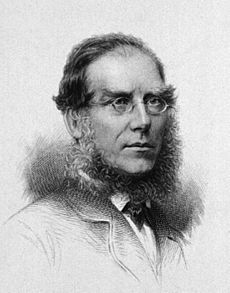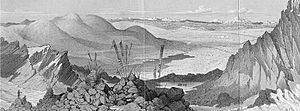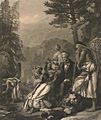Joseph Dalton Hooker facts for kids
Quick facts for kids
Sir Joseph Dalton Hooker
|
|
|---|---|
 |
|
| Born | 30 June 1817 Halesworth, Suffolk, England
|
| Died | 10 December 1911 (aged 94) Sunningdale, Berkshire, England
|
| Nationality | British |
| Alma mater | Glasgow University |
| Awards | Order of Merit (1907); Grand Cross Star of India; Royal Society Copley (1887) & Darwin Medals (1892); Linnean Society Linnean (1888) & Darwin–Wallace Medals (1908) |
| Scientific career | |
| Fields | Botany |
| Institutions | Kew Gardens |
| Influences | Sir William Jackson Hooker; Charles Darwin; George Bentham |
| Influenced | Thiselton-Dyer |
| Signature | |
Sir Joseph Dalton Hooker (born June 30, 1817 – died December 10, 1911) was a famous British botanist and explorer. He lived in the 1800s and was a very important scientist. Hooker helped create the study of geographical botany, which looks at where plants grow around the world.
He was also the closest friend of Charles Darwin, who developed the theory of evolution. Joseph Dalton Hooker followed in his father's footsteps, becoming the Director of the Royal Botanical Gardens, Kew, for twenty years. He received many of the highest awards in British science for his work.
Contents
Exploring the World
Joseph Dalton Hooker was a great explorer. He traveled to many parts of the world to study plants. These trips helped him learn about different plant species and how they grow in various environments.
Antarctic Expedition (1839–1843)
Hooker joined an expedition to the Antarctic aboard the HMS Erebus. This journey was one of the last major explorations done only by sail ships. Hooker was the youngest person on the crew, which had 128 men.
He worked as an assistant to the ship's surgeon. His job was to collect animal and rock samples. The ships sailed across the southern oceans, visiting places like South America, Australia, and New Zealand.
Hooker collected many plants at each stop. While sailing, he also drew plants, algae, and sea creatures that were caught in nets. After five months in the Antarctic, they returned to resupply. They then went to Sydney and New Zealand.
The ships went back to Antarctica for more exploration. After a long time at sea and a small collision, they sailed to the Falkland Islands and Tierra del Fuego. The expedition was a success. It helped confirm that a southern continent existed and mapped much of its coastline.
Himalayan and Indian Journey (1847–1851)
On November 11, 1847, Hooker left England for a three-year trip to the Himalayas. He was the first European to collect plants in this region. Hooker set up his base in Darjeeling, India.
He wrote letters to Darwin, describing the animals he saw in India. He also collected many plants in Bengal. In October 1848, Hooker and his local helpers went to eastern Nepal. They traveled through Nepal's passes into Tibet.
In April 1849, he began a longer trip into Sikkim. However, he was captured by the leader of Sikkim while traveling towards Tibet. A British team was sent to help. Hooker and his group were released without any fighting.
He returned to Darjeeling and spent time writing in his journals. He also replaced plant samples that were lost during his capture. In 1854, Hooker published his book, Himalayan Journals. This book described the new regions he had explored.
Middle East and Africa Trips
In the autumn of 1860, Hooker visited Syria and Palestine. He collected many plants there. He noticed that the plants in these areas could be divided into three main groups.
Hooker also traveled to Morocco from April to June 1871. He went with other botanists and a young gardener from Kew.
Western United States (1877)
Hooker visited the Western United States with his friend Asa Gray. Gray was a leading American botanist. They wanted to understand why some plants from Asia were found in the mountains of the Western United States.
Hooker returned to Kew with 1,000 dried plant samples. During his trip, he met Brigham Young, a leader of a new religion. Hooker found him respectable and well-spoken. He also noted that the city of Georgetown felt very safe and had plenty of food.
Hooker observed the plants in Colorado and Utah. He found different types of plant life. These included prairie plants, desert plants, and plants found in subalpine and alpine mountain areas.
Friendship with Darwin and Evolution
While on the Erebus, Hooker read some of Charles Darwin's book, The Voyage of the Beagle. He was very impressed by Darwin's skills as a naturalist. They had met briefly before Hooker's Antarctic trip.
After Hooker returned to England, Darwin asked him to help classify the plants he had collected. These plants were from South America and the Galápagos Islands. Hooker agreed, and they became lifelong friends.
In 1844, Darwin shared his early ideas about evolution and natural selection with Hooker. Hooker was very interested. In 1847, he read Darwin's "Essay" explaining the theory. He gave Darwin helpful feedback. Their letters continued as Darwin developed his ideas. Darwin once wrote that Hooker was "the one living soul from whom I have constantly received sympathy."
Hooker was Darwin's closest friend and trusted advisor. They wrote many letters and met often. When Darwin received a letter from Alfred Russel Wallace about natural selection, he turned to Hooker and Charles Lyell for advice.
Hooker played a key role in making sure Darwin's work was recognized. He helped arrange for Wallace's paper to be presented alongside Darwin's notes. This showed that Darwin had thought of natural selection earlier. Hooker formally presented this material to the Linnean Society in 1858. In 1859, Darwin thanked Hooker in his famous book, The Origin of Species.
In December 1859, Hooker published an essay supporting Darwin's theory. This was just one month after Darwin's book came out. Hooker became the first well-known scientist to publicly support Darwin's idea of evolution by natural selection.
In 1860, a famous debate about evolution took place in Oxford. Bishop Samuel Wilberforce spoke against Darwin's theory. Hooker and Thomas Henry Huxley defended it. According to Hooker, his arguments were the most effective against Wilberforce.
Hooker also served as president of the British Association in 1868. In his speech, he strongly supported Darwin's theories. Hooker was a close friend of Thomas Henry Huxley. He also became President of the Royal Society from 1873 to 1877.
Leading Kew Gardens
Through his travels and writings, Hooker became a highly respected scientist. In 1855, he was made Assistant-Director of the Royal Botanic Gardens, Kew. In 1865, he took over from his father as Director. He held this important position for twenty years.
Under the leadership of both Hookers, Kew Gardens became famous worldwide. At age thirty, Joseph Dalton Hooker was elected a Fellow of the Royal Society. He received three of its medals: the Royal Medal in 1854, the Copley Medal in 1887, and the Darwin Medal in 1892.
He continued to balance his work at Kew with his own explorations. His trips to Palestine, Morocco, and the United States all provided valuable information and plant samples for Kew Gardens.
Images for kids
-
Daguerreotype of Hooker by William Edward Kilburn, circa 1852
-
Frances Harriet Henslow, by William Edward Kilburn
-
Sir Richard Owen opposed Hooker in his planned expansion of Kew Photograph: Ernest Edwards, 1867
See also
 In Spanish: Joseph Dalton Hooker para niños
In Spanish: Joseph Dalton Hooker para niños











